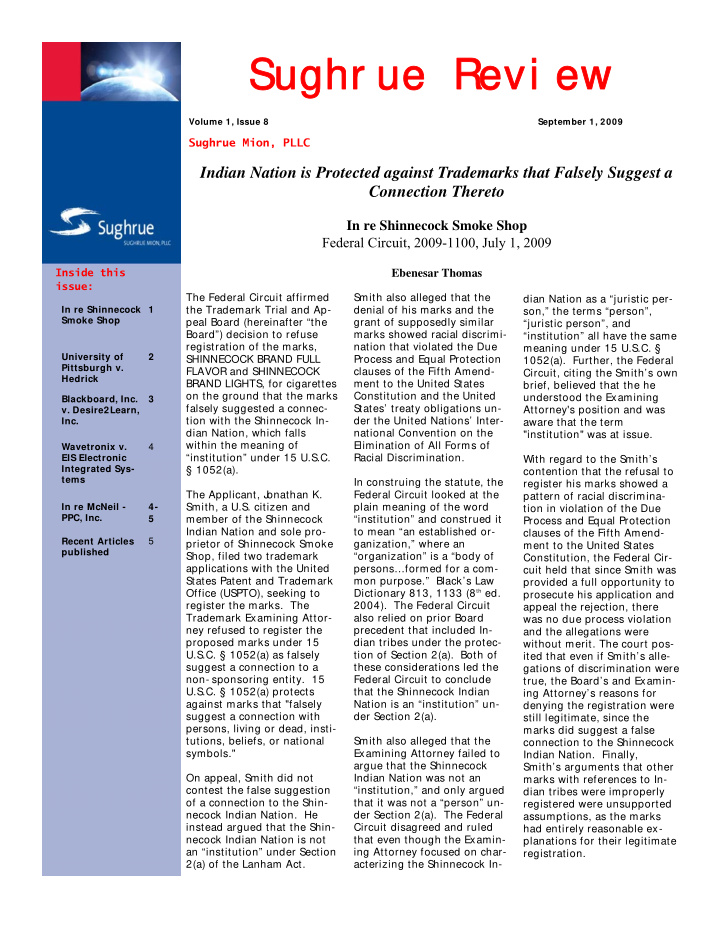



Sughr ue Revi ew Sughr ue Revi ew Volume 1, Issue 8 September 1, 2009 Sughrue Mion, PLLC Indian Nation is Protected against Trademarks that Falsely Suggest a Connection Thereto In re Shinnecock Smoke Shop Federal Circuit, 2009-1100, July 1, 2009 Inside this Ebenesar Thomas issue: The Federal Circuit affirmed Smith also alleged that the dian Nation as a “juristic per- In re Shinnecock 1 the Trademark Trial and Ap- denial of his marks and the son,” the terms “person”, Smoke Shop peal Board (hereinafter “the grant of supposedly similar “juristic person”, and Board”) decision to refuse marks showed racial discrimi- “institution” all have the same registration of the marks, nation that violated the Due meaning under 15 U.S.C. § University of 2 SHINNECOCK BRAND FULL Process and Equal Protection 1052(a). Further, the Federal Pittsburgh v. FLAVOR and SHINNECOCK clauses of the Fifth Amend- Circuit, citing the Smith’s own Hedrick BRAND LIGHTS, for cigarettes ment to the United States brief, believed that the he on the ground that the marks Constitution and the United understood the Examining Blackboard, Inc. 3 falsely suggested a connec- States’ treaty obligations un- Attorney's position and was v. Desire2Learn, tion with the Shinnecock In- der the United Nations’ Inter- Inc. aware that the term dian Nation, which falls national Convention on the "institution" was at issue. within the meaning of Elimination of All Forms of Wavetronix v. 4 EIS Electronic “institution” under 15 U.S.C. Racial Discrimination. With regard to the Smith’s Integrated Sys- § 1052(a). contention that the refusal to tems In construing the statute, the register his marks showed a The Applicant, J onathan K. Federal Circuit looked at the pattern of racial discrimina- In re McNeil - 4- Smith, a U.S. citizen and plain meaning of the word tion in violation of the Due PPC, Inc. 5 member of the Shinnecock “institution” and construed it Process and Equal Protection Indian Nation and sole pro- to mean “an established or- clauses of the Fifth Amend- Recent Articles 5 prietor of Shinnecock Smoke ganization,” where an ment to the United States published Shop, filed two trademark “organization” is a “body of Constitution, the Federal Cir- applications with the United persons…formed for a com- cuit held that since Smith was States Patent and Trademark mon purpose.” Black’s Law provided a full opportunity to Office (USPTO), seeking to Dictionary 813, 1133 (8 th ed. prosecute his application and register the marks. The 2004). The Federal Circuit appeal the rejection, there Trademark Examining Attor- also relied on prior Board was no due process violation ney refused to register the precedent that included In- and the allegations were proposed marks under 15 dian tribes under the protec- without merit. The court pos- U.S.C. § 1052(a) as falsely tion of Section 2(a). Both of ited that even if Smith’s alle- suggest a connection to a these considerations led the gations of discrimination were non- sponsoring entity. 15 Federal Circuit to conclude true, the Board’s and Examin- U.S.C. § 1052(a) protects that the Shinnecock Indian ing Attorney’s reasons for against marks that "falsely Nation is an “institution” un- denying the registration were suggest a connection with der Section 2(a). still legitimate, since the persons, living or dead, insti- marks did suggest a false tutions, beliefs, or national Smith also alleged that the connection to the Shinnecock symbols." Examining Attorney failed to Indian Nation. Finally, argue that the Shinnecock Smith’s arguments that other On appeal, Smith did not Indian Nation was not an marks with references to In- contest the false suggestion “institution,” and only argued dian tribes were improperly of a connection to the Shin- that it was not a “person” un- registered were unsupported necock Indian Nation. He der Section 2(a). The Federal assumptions, as the marks instead argued that the Shin- Circuit disagreed and ruled had entirely reasonable ex- necock Indian Nation is not that even though the Examin- planations for their legitimate registration. an “institution” under Section ing Attorney focused on char- 2(a) of the Lanham Act. acterizing the Shinnecock In-
Recommend
More recommend